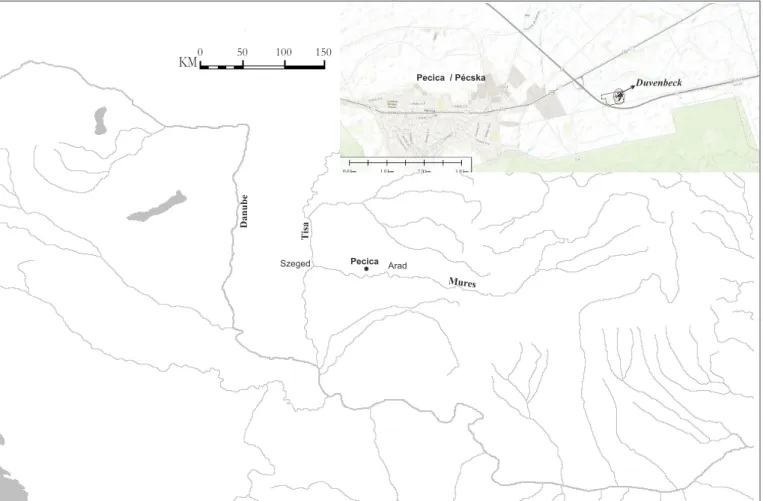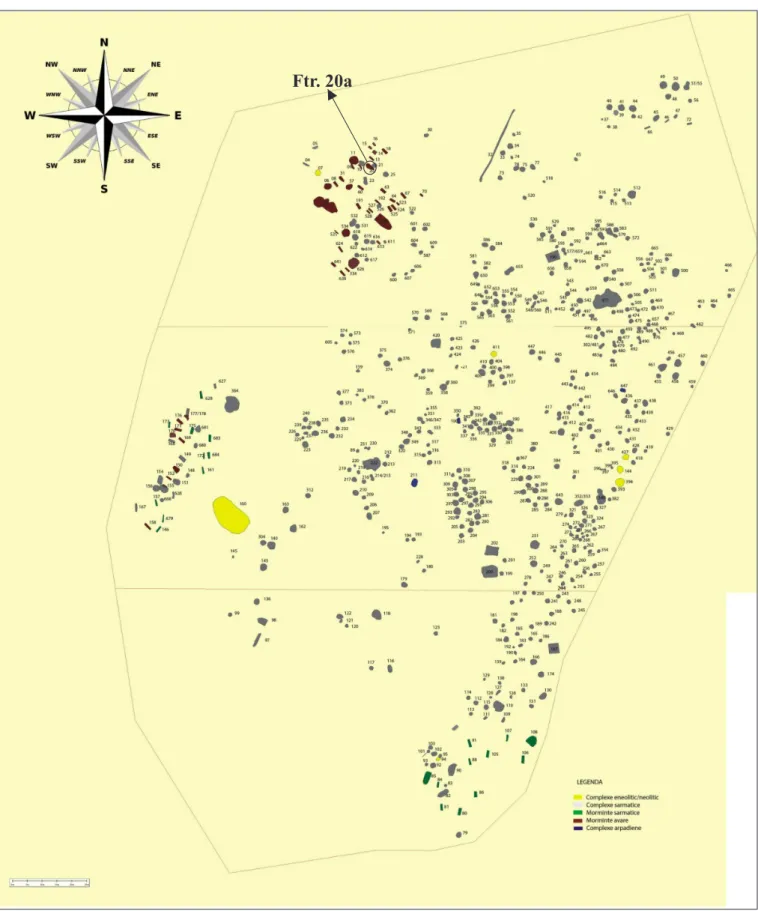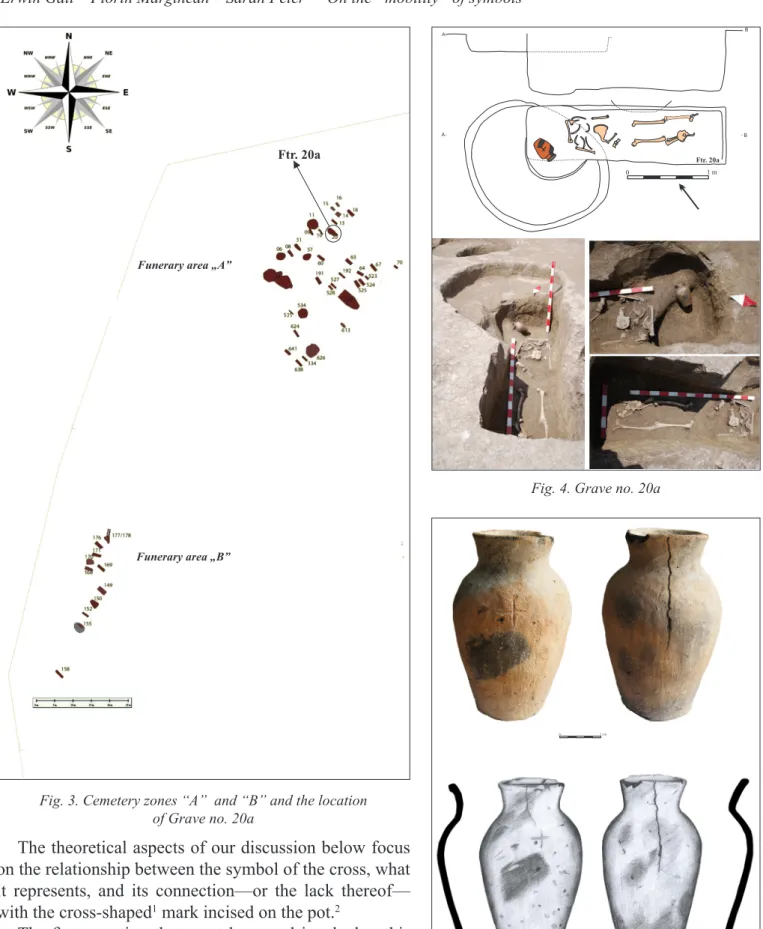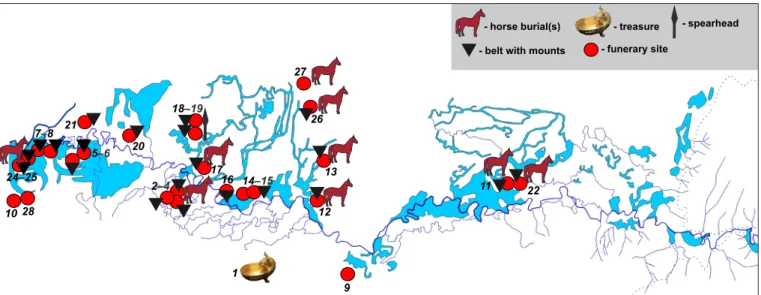ON THE “MOBILITY” OF SYMBOLS.
The sign of the cross found on a pot from a grave at Pecica-Duvenbeck
Erwin Gáll – Florin MˇarGinEan – Sarah PEtEr
Hungarian Archaeology Vol. 8 (2019), Issue 4, pp. 28–35, https://doi.org/10.36338/ha.2019.4.2
Interpreting grave goods always poses a challenge to the archaeologist; objects in the grave and their position serve as the main basis to draw conclusions about associated rituals and belief systems, and to explain how and why a weapon, a horse harness or a ceramic vessel was buried beside the dead. Interpret- ing symbols used in various religions and found on objects recovered from Avar period graves is even more difficult as no written accounts exist that could reveal the beliefs of these populations. A pot recently found in a late Avar grave and decorated with a cross poses all these questions, and to find the answer one has to look into the contemporaneous use and meaning of symbols in addition to the possible religion-related interpretations.
During the rescue excavations in Pecica-Duvenbeck in 2018 (Fig. 1), 582 features were brought to light, dated to different periods (Fig. 2). Two groups of graves were dated to the 8th–9th century (funerary areas
“A” and “B”) (Fig. 3). An adultus/maturus woman, with an estimated age of over 30, was buried in Grave no. 20a, oriented NW‒SE, partially disturbed when looted. The position of the skeleton in the grave was not unusual. Her estimated height was 159.20–161.98 cm and ‘Schmorl’s nodes’ were identified on two of her lumbar vertebrae (Fig. 4).
KM0 50 100 150
Pecica
Szeged Arad
TisaDanube
Duvenbeck
Mures Pecica / Pécska
Fig 1. The macro- and micro-topographic position of Pecica-Duvenbeck
Erwin Gáll – Florin Mărginean – Sarah Peter • On the “mobility” of symbols
A hand-modelled pot was deposited in the grave as a form of drink or food offering. A cross sign with almost equal arms had been incised under the neck of this pot before firing (Fig. 5), which raises a number of questions in terms of interpreting the grave and the mark itself. The grave was looted, and therefore only a single element of the ritual can be documented with certainty, i.e. the deposition of the pot near the head of the deceased woman.
Fig. 2. A comprehensive map of the excavations at Pecica-Duvenbeck (by Adrian Ursuțiu, Gelu Copos)
Ftr. 20a
The theoretical aspects of our discussion below focus on the relationship between the symbol of the cross, what it represents, and its connection—or the lack thereof—
with the cross-shaped1 mark incised on the pot.2
The first question that must be posed is whether this mark should be interpreted as a symbol or as a simple ele- ment of decoration, without any definite meaning attached to it.
1 The sign of the cross is one of the basic signs in the history of humanity, see Frutiger, 1989, p. 43. On the development of the shape of the cross during the 1st millennium AD, see DáviD, 2012.
2 The pot belongs to type IIIA1/b1 (viDa, 1999, p. 119, Abb. 36).
Ftr. 20a
Funerary area „B”
Funerary area „A”
+
+
+
A+
A B
B
0 1 m
Ftr. 20a
0 5 cm
0 5 cm
Fig. 3. Cemetery zones “A” and “B” and the location of Grave no. 20a
Fig. 4. Grave no. 20a
Fig. 5. The pot from Grave no. 20a (photo by Florin Mărginean; drawing by Alexandra Sighete)
Erwin Gáll – Florin Mărginean – Sarah Peter • On the “mobility” of symbols
SIGNS, SYMBOLS AND THEIR INTERPRETATION
Various disciplines focus on the analysis and interpretation of signs and symbols on objects, and the discus- sion of such an archaeological find has to begin with an overview of these theories. As a starting point one can accept the following definition of symbols: “object, image or graphic entity that points to or denotes something else, other than itself. The connection between a symbol and its meaning is established on the basis of circumstantial conventions.”3 According to C. G. Jung, all symbols are based on archetypes that rest between consciousness and the subconscious and establish a connection between that which is hidden and that which is revealed (Jung, 1964). While analysing symbols, one can also take into consideration their polysemantic character. As P. Niedermüller also emphasises, the meaning of symbols depends on their social-historical and socio-cultural contexts (nieDermüller, 1993, p. 158). These theories are analogous to K. Mannheim’s observations that transplanting ideas and symbols from one socio-cultural context to another will profoundly transform their basic meaning and functionality (mannheim, 1995, pp. 36, 131).
The ideas of Mannheim and Niedermüller are, from a theoretical perspective, related to Á. Bollók’s analysis of Christian signs and symbols from the Eastern Mediterranean and the Carpathian Basin during the 5th–10th centuries (Bollók, 2016, pp. 133–149). Partially adopting P. Brown’s results, Bollók specified that during Late Antiquity the sign of the cross replaced other objects (e.g. crotal bells, small bells, minia- ture rooster-shaped objects) but had the same role as apotropaion, a protective device against demons. The custom of using protective symbols was essentially pagan but it was integrated into Christianity, and Chris- tian symbols, such as the sign of the cross, started to be used in place of the pagan ones. However, even in the Christian context of the Empire these symbols retained their apotropaic function, so the pagan meaning was never lost, even less so in the Barbaricum.
Artefacts and signs that one can interpret as apotropaic based on their context, have been known since ancient times, both in the extended areas of “civilized” Eurasia (Brown 1970, p. 28) and on its periphery, also among these pagan populations. An episode that took place in 591 can be mentioned to illustrate this;
a group of presumably Eastern Turkic people arrived in Constantinople wearing cross-signs on their fore- heads. When asked about the origin of these signs, they recounted how, during a plague epidemic, Chris- tians suggested to their forefathers to tattoo the sign of the cross on the foreheads of their children (Brown, 2013, p. 267). Thus, the sign of the cross was transformed, integrated into the values, beliefs, practices and mentalities of a Barbarian environment. However, the Barbarian populations failed to adopt the meaning of the apotropaion and adopted only its shape, the sign of the cross. The custom of wearing protective symbols had already been widespread; only a new marking, believed to be effective, was adopted in this case.
To place into context the sign of the cross found in Grave 20a, one may attempt a “deep interpretation”
formulated by cultural anthropologist R. M. Keesing. Based, on one hand, on F. Barth’s research, Keesing noted that participants of a ritual rarely have the same understanding of the meaning of the symbols used;
most of them will interpret the symbols only superficially. The meaning is strongly influenced by one’s knowledge, and therefore, ritual activities can bear different meanings for different members of the same community, ranging from the superficial, mundane interpretations to “deep” and universal ones. Thus, the meaning of a symbol is manifested in different ways, basically varying from one individual to the other (keesing, 2012, pp. 406–407).
The adoption of a symbol based on an initial visual contact provides at most the opportunity of under- standing the outer layers of its symbolic meaning (keesing, 2012, p. 422; Barth, 1975, pp. 177–178); the deep message, the core meaning of the symbol remains a secret known only to the initiates, a restricted cir- cle of people who have the privilege of understanding it (Barth, 1975, pp. 177–178).4 In our view, outside the cultural habitus of the associated individual or micro-community (BourDieu, 2002, pp. 27–34), symbols can be used only as totemic emblems (for a group or a person) or as apotropaic marks, simply due to the lack of knowledge of the codes of the initial meaning. The case of the Eastern Turkic group wearing cross-
3 DPS 1995, p. 224. For another synthesis, see Frutiger, 1989, pp. 235–237.
4 keesing (2012, p. 426) believes these observations to be of universal validity.
signs on their foreheads may be brought up again as an example. As Brown notes, the adopted symbol of the cross played an apotropaic role for them. However, in our opinion the cross also became a group emblem in this case, with no connection to its original context of meaning, i.e. Christianity.
A contemporary case the authors have observed should also be mentioned here. In 2010–2013 one could see the Mercedes logo on the facade of a palace in a settlement in Cluj County (Romania). The psycholog- ical process was clear: in a certain context, the owner came into contact with the logo of a supranational corporation, perhaps for the first time. For him, using the company’s logo was a way to adopt it and make it into a personal emblem, without having any connection to or being part of the company.
A schematic model of the four stages of the cognitive subconscious process in the adoption of the cross symbol is summarized in Fig. 6.
OBSERVATIONS
As discussed above, the mobility of symbols, and through it the transfiguration of their meanings from one socio-cultural context to another, raises doubts about the interpretation that the cross-shaped symbol from Pecica could be linked to the Christian world; namely there is no connection between the deceased or her micro-community and Christianity.
1. The immediate archaeological context of the funerary space, i.e. of the grave, raises even more scepticism. Graves and burials with horses, offerings of drink and food, and the grave goods in this micro-community imitated the status display customary for the elite of the Avar Khaganate. Placing a pot with food or drink in the grave was a well-known custom also in the pagan Avar commuities.
The funerary cultural habitus observed at Pecica-Duvenbeck is very close to that of the late Avar period both on a micro- (the Lower Mures) and on a macro-regional level (the Carpathian Basin) (szenthe, 2019) (Fig. 7).
2. As ecclesiastic networks were non-existent in the Avar territory, the Church refused to recognize individuals from outside the Empire as proper Christians in the theological sense of the word (heu-
ssi, 2000, pp. 53, 56, 63, 72, 79).
3. Cs. Bálint’s observations are closely related to the ones above. He hypothesises that the presence of cross shapes that were uncommon in the Christian world suggests that these Avar markings were not standardized but appeared in connection with specific events only (Bálint, 2004, p. 483). From this perspective, the sketchy cross with uneven arms incised on the surface of the Pecica pot suggests that the one who made it was uncertain or, perhaps, ignorant of what a cross looked like.
4. There are analogies for cross-shaped signs on the sides of pots dated to the 7th–9th centuries, found typically in pagan necropolises (e.g. Deszk-T, Grave no. 63, Vác-Kavicsbánya, Grave no. 302); even crosses were found in such non-Christian funerary contexts. As Vargha argued, in only one case was
visual contact with the symbol
adoption of the symbol's shape cognitive reaction
and the influence of the symbol upon the
individual
/ micro-community adoption as emblem
(the main possibility) +%
adoption as symbol (low possibility) -%
without psychological impact negative psychological impact
Fig. 6. The transfer of symbols and the interpretation of the associated psychological process
Erwin Gáll – Florin Mărginean – Sarah Peter • On the “mobility” of symbols
a cross unearthed from a Christian cemetery from this region and period, and, ironically, this specific case was interpreted as a surviving pagan custom (vargha, 2015, pp. 59, 61). This process is clearly illustrated in Fig. 6.
Avar period funerary customs in the Carpathian Basin have no connections to those in the Christian areas of the Mediterranean region. The communities of the new world forged by the Christian faith and their cul- tural habitus had nothing to do with the cultural characteristics of the Avar Khaganate, a state formed by steppe peoples of Asian origin. Therefore, it is virtually impossible that the cross-shaped mark on the Pecica pot had the same meaning as the Christian symbol, in an environment dominated by a cultural habitus entirely different from the Christian world. Therefore, an interpretation as an apotropaion, i.e. as a symbol adopted and transformed according to the pagan mentalities of the 8th century, is a more plausible explanation.
This paper was published as part of the Thematic Excellence Programme – NKFIH-832-15/2019 – ‘Late Avar Reform and consequences’.
BiBliography
Barth, F., 1975.
Ritual and Knowledge among the Baktaman of New Guinea. New Haven, CT: Yale University Press.
Bálint, Cs., 2004.
A nagyszentmiklósi kincs [The Treasure of Nagyszentmiklós]. Varia Archaeologica Hungarica 16a.
Budapest: Balassi Kiadó.
Bollók, Á., 2016.
A „kereszt-phylaktērion” és a mellkereszttel való temetkezés szokásának háttere a késő ókori Kelet- Mediterráneumban és a Kárpát-medencében [The background of the “cross- phylaktērion” and the custom of interring the dead with a pectoral cross in the Ancient East-Mediterranean and in the Carpathian Basin].
In: T. Csécs & M. Takács, eds., Beatus homo qui invenit sapientiam. Ünnepi kötet Tomka Péter 75.
születésnapjára. Győr: Lekri Group, pp. 133–150.
9
11 22
12 14‒15 13
16
1 17 2‒4
5‒6
10
18‒19 20
7 8‒ 21
24 25‒ 28
27 26
- horse burial(s) - belt with mounts
- spearhead - treasure
- funerary site
Fig. 7. Late Avar cemeteries and burial grounds in the Lower Mures region (late 7th–early 9th c.): 1. Nagyszentmiklós (Ro.:
Sânnicolau Mare); 2‒4. Kiszombor - Sites A, G, J; 5‒6. Klárafalva-situl F and Vasút Street; 7‒8. Deszk-Olajkút and Site D;
9. Perjámos (Ro.: Periam)-Sánchalom; 11. Pécska (Ro.: Pecica), Site 15; 12‒13. Nagylak (Ro.: Nădlac),7M and 3M-S; 14‒15.
Magyarcsanád-Belezi dűlő and Talágy dűlő; 16. Apátfalva; 17. Makó-Innenső-Jángor 3; 18‒19. Óföldeák-Döbörcsök halom and Két-halom dűlő; 20. Maroslele-Gyűrűs II; 21. Tápé-Lebő-Kishomokos; 22. Pécska (Ro.: Pecica)-Duvenbeck; 23. Óbéba
(Ro.: Beba Veche); 24‒25. Szőreg Site B and “Belső ugar”; 26‒27. Pitvaros-Víztárazó and Lenin Street
BourDieu, P., 2002.
Habitus. In: J. Hillier & E. Rooksby, eds., Habitus: A Sense of Place. Burlington: Ashgate, 27–34. https://
doi.org/10.4324/9781315253701.
Brown, P., 1970.
Sorcery, demons, and the rise of Christianity from Late Antiquity into the Middle Ages. In: M. Douglas, ed., Witchcraft: Confessions and Accusations. London: Tavistock Publications, pp. 17‒45. doi: https://doi.
org/10.4324/9780203708545 Brown, P., 2013.
The Rise of Western Christendom: Triumph and Diversity, A.D. 200–1000. 10th, revised edition. Malden, MA: Wiley-Blackwell.
DáviD, K., 2012.
A kereszt teológiai és ikonográfiai értelmezése az első évezredben [The theological and iconographic interpretation of the cross in the 1st millennium]. Budapest: Szent István Társulat.
DPS 1995.
Dicționar de psihologie socială [The dictionary of social psychology]. București: Ed. Științifică și Enciclopedică.
Frutiger, A., 1989.
Signs and Symbols: Their Design and Meaning. New York, NY: Van Nostrald Rheinhold.
Jung, C. G., 1993.
Approaching the unconscious. In: C. G. Jung, M.-L. von Franz, J. L. Henderson, J. Jacobi & A. Jaffé, Man and His Symbols. New York – London: Anchor Press, pp. 18‒103.
heussi, K., 2000.
Az egyháztörténet kézikönyve [The encyclopaedia of church history]. Budapest: Osiris.
keesing, M. R., 2012.
On not understanding symbols. Toward an anthropology of incomprehension. HAU: Journal of Ethnographic Theory, 2(2), pp. 406–430. https://doi.org/10.14318/hau2.2.023.
mannheim, K., 1995.
A gondolkodás struktúrái. Kultúraszociológiai tanulmányok [The structures of thinking. Studies in the sociology of culture]. Budapest: Atlantisz.
nieDermüller, P., 1993.
Megjegyzések a „szimbolikusról” [Notes on the ‘symbolic’]. Replika, 11‒12, pp. 157‒167.
szenthe, G., 2019.
Növényi ornamentika a késő avar kori díszítő művészetben. Kultúrtörténeti tanulmányok. [Floral ornaments in late Avar period decorations. Studies in cultural history]. Budapest (in press).
vargha, M., 2015.
Hoards, Grave Goods, Jewellery. Objects in Hoards and in Burial Contexts during the Mongol Invasion of Central-Eastern Europe. Oxford: Archaeopress.
Erwin Gáll – Florin Mărginean – Sarah Peter • On the “mobility” of symbols viDa, T., 1999.
Die awarenzeitliche Keramik I. Varia Archaeologica Hungarica 8. Berlin ‒ Budapest: MTA Régészeti Intézet.




